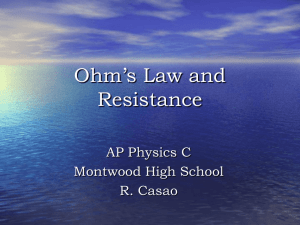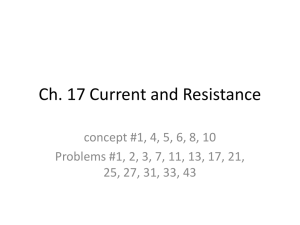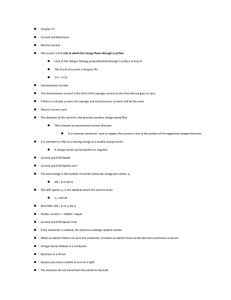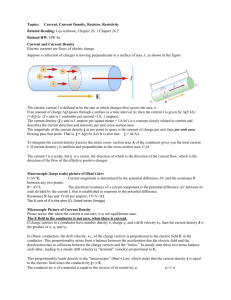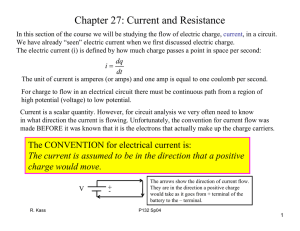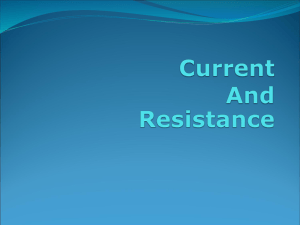Chapter 17
advertisement
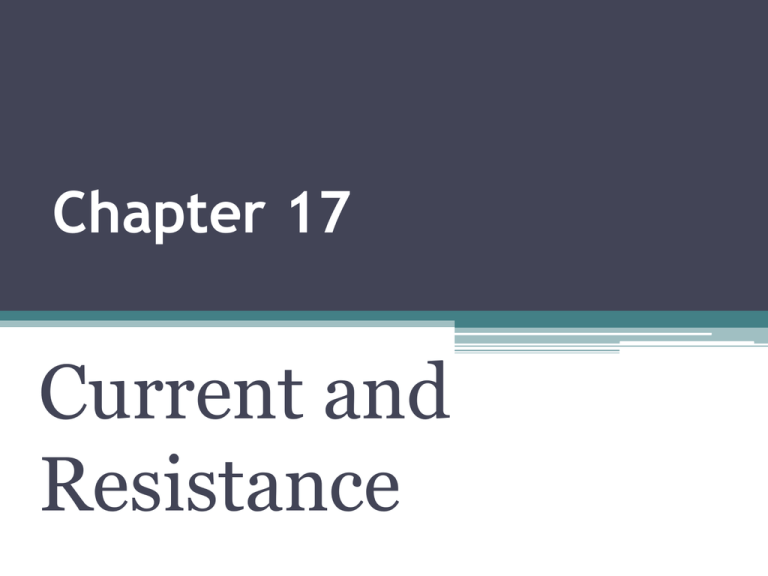
Chapter 17 Current and Resistance Electric Current • The current is the rate at which the charge flows through a surface. ▫ Look at the charges flowing perpendicularly through a surface of area A: Iav Q t • The SI unit of current is Ampere (A) ▫ 1 A = 1 C/s Sample Problem The amount of charge that passes through a filament of a certain light bulb in 2.00 s is 1.67 C. Find (a) the current in the light bulb and (b) the number of electrons that pass the filament in 1 s. Sample Problem If a current of 80.0 mA exists in a metal wire, how many electrons flow past a given cross section of the wire in 10.0 min? Sketch the directions of the current and the electrons’ motion. Electric Current • The direction of the current is the direction positive charge would flow. ▫ This is known as conventional current direction. In a common conductor, such as copper, the current is due to the motion of the negatively charged electrons. • It is common to refer to a moving charge as a mobile charge carrier. ▫ A charge carrier can be positive or negative. Circuits • A circuit is a closed path of some sort around which current circulates. • A circuit diagram can be used to represent the circuit. • Quantities of interest are generally current and potential difference. Resistance • In a conductor, the voltage applied across the ends of the conductor is proportional to the current through the conductor. • The constant of proportionality is the resistance of the conductor: V R I Resistance • Units of resistance are ohms (Ω): ▫ 1Ω=1V/A • Resistance in a circuit arises due to collisions between the electrons carrying the current with the fixed atoms inside the conductor: Ohm’s Law • Experiments show that for many materials, including most metals, the resistance remains constant over a wide range of applied voltages or currents. • This statement has become known as Ohm’s Law: ▫ ΔV = I R ▫ A simple rearrangement of the resistance equation. • Ohm’s Law is an empirical relationship that is valid only for certain materials. ▫ Materials that obey Ohm’s Law are said to be ohmic. Sample Problem All electric devices are required to have identifying plates that specify their electrical characteristics. The plate on a certain steam iron states that the iron carries a current of 6.4 A when connected to a 120 V source. What is the resistance of the steam iron? Sample Problem A person notices a mild shock if the current along a path through the thumb and the index finger exceeds 80µA. Compare the maximum allowable voltage without shock across the thumb and index finger with a dry-skin resistance of 4.0x105 Ω and a wet skin resistance of 2 000 Ω. Ohmic vs. Nonohmic Resistivity • The resistance of an ohmic conductor is proportional to its length, L, and inversely proportional to its cross-sectional area, A: R A ▫ ρ is the constant of proportionality and is called the resistivity of the material. ▫ Units for ρ: .m Sample Problem A rectangular block of copper has sides of length 10 cm, 20 cm, and 40 cm. If the block is connected to a 6.0 V source across opposite faces of the rectangular block, what are (a) the maximum current and (b) minimum current that can be carried? Values for Resistivities Temperature Variation of Resistivity • For most metals, resistivity increases with increasing temperature: ▫ With a higher temperature, the metal’s constituent atoms vibrate with increasing amplitude. ▫ The electrons find it more difficult to pass through the atoms. Temperature Variation of Resistivity • For most metals, resistivity increases approximately linearly with temperature over a limited temperature range: o [1 (T To )] ▫ ρ is the resistivity at some temperature T. ▫ ρo is the resistivity at some reference temperature To . To is usually taken to be 20° C. ▫ is the temperature coefficient of resistivity. Temperature Variation of Resistance • Since the resistance of a conductor with uniform cross sectional area is proportional to the resistivity, you can find the effect of temperature on resistance: R Ro [1 (T To )] Electrical Energy in a Circuit • In a circuit, as a charge moves through the battery, the electrical potential energy of the system is increased by ΔQΔV. ▫ The chemical potential energy of the battery decreases by the same amount. • As the charge moves through a resistor, it loses this potential energy during collisions with atoms in the resistor. ▫ The temperature of the resistor will increase. Energy Transfer in the Circuit • As the charge moves through the resistor, from C to D, it loses energy in collisions with the atoms of the resistor. • The energy is transferred to internal energy . • When the charge returns to A, the net result is that some chemical energy of the battery has been delivered to the resistor and caused its temperature to rise. Electrical Energy and Power • The rate at which the energy is lost is the power: Q V I V t • From Ohm’s Law, alternate forms of power are: V I R R 2 2 Electrical Energy and Power • The SI unit of power is Watt (W). ▫ I must be in Amperes, R in ohms and V in Volts. • The unit of energy used by electric companies is the kilowatt-hour. ▫ This is defined in terms of the unit of power and the amount of time it is supplied. ▫ 1 kWh = 3.60 x 106 J Sample Problem How many 100 W light bulbs can you use in a 120 V circuit without tripping a 15 A circuit breaker? (The bulbs are connected in parallel, which means that the potential difference across each bulb is 120 V). Chapter 17 Current and Resistance THE END



